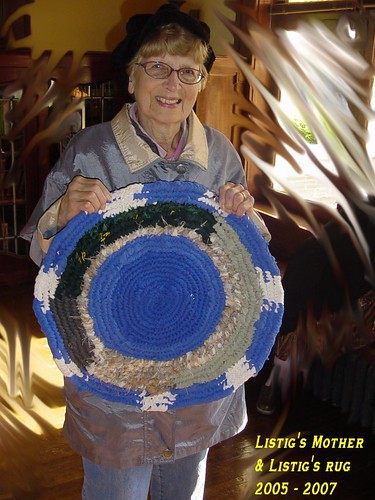As usual, mixed in with the action I give tips and tricks of the craft, and a special feature of this series is Tess is in the room off camera and we have some nice flirty badinage.
Part I: Finishing off an umbrella done in by a recent wind storm in Chicago
Wind... in Chicago... how could that be?! *grin*Online Videos by Veoh.com
Part II: Destroying for rug making purposes an umbrella which we have no intention of using because it triggers bad memories for us...
So not only are these rugs a way to preserve GOOD memories, but a way to redeem bad ones... its fun to take something which reminds you of a bad experience, cut it up, and put it in a rug!Online Videos by Veoh.com
Now we move from DEstruction to CONstruction
I cut a strip from the black umbrella, and add it to a rug I'd started from a shower curtain. Now, usually rugs made from plastic materials are pretty bland looking- think about the colors grocery bags come in!- but this one will come out very lovely I think.Other people have been known to use bread bags and newspaper bags, including my own dear mother. More power to them! These bags tend to be stretchier and have more friction, so you need a looser stitch than I am wont to use. But if you want to do it... why not! Just be aware that if you pull too tightly, the bags will stretch out, and when you do the pull through, it'll tend to "seize up" on you.
Still... my mother made a huge square one (that's for another series of tutorials, probably NEXT YEAR!) from yellow newspaper bags, and it was lovely. It worked as her doormat for about 10 years instead of the usual 40+, but hey, this is all about using things which would be wasted otherwise, and having fun... so if that floats your boat... anchors away!
Online Videos by Veoh.com










